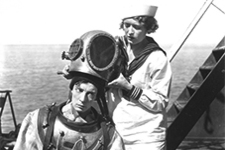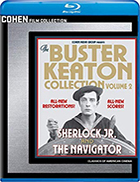The Navigator
|  The Navigator is an amusing Buster Keaton comedy—hardly one of his best, but one that certainly has more than its share of pleasures. It was Keaton’s fourth feature-length film, following Three Ages (1923), Our Hospitality (1923), and his masterpiece Sherlock, Jr., which was released the same year. The Navigator was a significant financial success for Keaton, even though it incurred significant production costs (including the rebuilding of a swimming pool that was destroyed while filming underwater scenes and the purchase of a 5,000-ton ocean liner destined for the scrap yard) that raised the ire of Keaton’s longtime producer, Joseph Schenck. Keaton plays Rollo Treadway, a wealthy young man who is not exactly the prize of his powerful family. Rollo is a variation on Bertie Van Alstyne, the naïve, coddled, simple-minded playboy Keaton played in The Saphead (1920), a figure of amusement that Keaton had been wanting to recreate. After seeing blissful newlyweds out his window, Rollo decides that the time has come for him to marry, so he immediately goes across the street (driven by his chauffeur, of course) and proposes to his girlfriend Betsy O’Brien (Kathryn McGuire), who promptly turns him down. Distraught, Rollo decides to go ahead and take the honeymoon cruise to Honolulu he had already booked for them, but instead winds up on the deserted ship of the title, which happens to have been recently sold by Betsy’s father to a small country needing ships for war. While he is asleep in his cabin, the ship is cut loose by spies from an opposing country, but not before Betsy also boards the ship looking for her father. Thus, the would-be betrothed couple find themselves floating alone on the open ocean, which offers a wide range of opportunity for all manner of mayhem, much of it arising from the fact that they, both being pampered rich kids, have no idea how to manage things for themselves. After a few weeks at sea they get things under control, and one of the film’s most amusing setpieces shows how they have rigged up a series of Rube Goldberg contraptions involving ropes and pullies to complete basic tasks like making coffee. Rollo and Betsy eventually find land, only to discover that it is the province of a tribe of dark-skinned cannibals. This, unfortunately, means that a significant chunk of the film is mired in uncomfortable stereotypes involving primitive, ooga-booga black men in loin cloths jumping around and being threatening, only to be easily turned into buffoons by Rollo and Betsy. The chief of the cannibals was played by Noble Johnson, an African-American actor and film pioneer whose impressive sounding name matched his impressive stature. He was one of the co-founders of the Lincoln Motion Picture Co., the first black-owned production company to specialize in so-called “race movies,” which were made specifically for black audiences who otherwise did not see themselves represented on-screen except in roles like the ones that Johnson had to take in films like The Navigator to pay the bills (like John Cassavettes and Orson Welles would do later, he paid for his own productions by acting in others’). Keaton codirected The Navigator with Donald Crisp, an actor-turned-directed who had worked as an assistant for D.W. Griffith and had memorably played Lillian Gish’s drunken, abusive father in Broken Blossoms (1919) (he would abandon directing after 1930 and return to acting full time, and he later won an Oscar for Best Supporting Actor in John Ford’s How Green Was My Valley). Keaton had hired Crisp to direct the film’s dramatic scenes, but soon found that Crisp was more interested in helming the comedy scenes. Keaton, never one to cede control, told Crisp that production was finished, and then went back and reshot his scenes. Interestingly, Keaton, despite asserting control, never put together one of his fabled trajectory gags, and you can really feel its absence. He has a great underwater bit in which Rollo dons a massive diving suit and attempts to repair the hull of the leaking ship, but at one point finds himself dueling with a swordfish using another swordfish in an inspired bit of goofy, cartoonish fun. It’s a wonderfully funny moment, even if the film as a whole doesn’t live up to Keaton’s greatest work.
Copyright © 2019 James Kendrick Thoughts? E-mail James Kendrick All images copyright © Cohen Film Collection | |||||||||||||||||||||||||||||||
Overall Rating: 

 (3)
(3)


